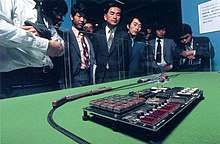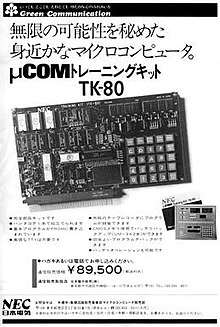TK-80
 TK-80 (assembled) | |
| Developer | Tomio Goto, Akira Kato[1] |
|---|---|
| Manufacturer | NEC |
| Type | Single-board computer |
| Release date | August 3, 1976[2] |
| Introductory price |
¥88,500 (equivalent to ¥144,372 in 2013) |
| Units sold | 17,000 (as at October 1977)[3] |
| CPU | NEC μPD8080A 2.048 MHz |
| Memory | ROM 768 bytes、RAM 512 bytes |
| Display | 8 hexadecimal digits; 7-segment display |
| Input | 25 keys |
| Connectivity | 110 bps Serial I/O、3 x 8 bits Parallel I/O |
| Power | DC +5V 1.0 A, +12V 0.15 A |
| Dimensions | 310(W) x 180(D) mm |
The TK-80 (Training Kit μCOM-80) was an 8080-based single-board computer kit developed by Nippon Electric Company (NEC) in 1976. It was originally developed for engineers who considered using the μCOM-80 family in their product. It was successful among hobbyists in late 1970s in Japan, due to its reasonable price and an expensive computer terminal not being required.
History
On February 1976, NEC formed the Microcomputer Sales section in the Integrated Circuit division, and began to provide development environments for their microprocessors. However, they visited customers and explained, but it was difficult for them to understand how to use a microprocessor. At the same time, NEC received an order from a laboratory in the Yokosuka Communication Institute (横須賀通信研究所) of NTT that they wanted an educational microcomputer product for their new employees. Tomio Gotō (後藤富雄), a member of the section, proposed to his manager Kazuya Watanabe (渡辺和也) developing an educational kit.[1][2]
Goto mainly designed the TK-80, and Akira Katō (加藤明) did the detailed design work.[1] Goto got an idea from a photo of the KIM-1. The KIM-1 can monitor and show the current address by the software, but the display disappers when the CPU is hanging. The TK-80 has the Dynamic Display using the 555 timer IC and interrupt the CPU, it can always show the current address. In addition, the TK-80 has a CMOS battery. He decided to document its manual with a circuit diagram and assembly code of the debug monitor, influenced by the PDP-8 which was an open architecture.[4]


The TK-80 came out on August 3, 1976. It was priced at 88,500 yen, an engineer's section manager could approve at that time. NEC had opened a support center (Bit-INN) at the Akihabara Radio Kaikan on September 13, 1976. They found many machines were sold to not only electrical engineers but also businessmen, hobbyists and students. The TK-80 was sold more than 2000 units per month, despite 200 units expected.[2]
Soon after its success, other Japanese microprocessor manufacturers developed an evaluation kit for their microprocessor. Power supplies and other peripherals came out from third parties. Watanabe and his members wrote an introductory book Mi-com Introduction (マイコン入門) on July 1977, it became very popular and sold more than 200,000 copies.[1] Also, some computer magazines were founded, the ASCII, the I/O, the Monthly Mi-com (月刊マイコン) and the RAM.
In Japan, the Altair 8800 was sold in 1975, but not successful due to its high brokerage fee. Neither the Apple II nor the Commodore PET.[6] Single-board computers had been popular until the successor PC-8001 came out in 1979.
Variants
The TK-80E was a cost-reduced version priced at 67,000 yen, introduced on December 1977.[2] It contained the NEC μPD8080AF, fully compatible with the Intel 8080A. (Original Intel 8080A has a bug in the BCD adjustment. The μPD8080A doesn't.)
The TK-80BS was introduced on December 1977. It included a keyboard, a backplane and an expansion board for the TK-80 with 5KB RAM and 12KB ROM. It supported 8K BASIC.
The COMPO BS/80 was a fully assembled unit of the TK-80BS, introduced in 1978. It was not a success because of its poor built-in BASIC and slow clock speed.[7]
Literature
- μCOM-80トレーニング・キット TK-80E/80ユーザーズ・マニアル [μCOM-80 Training Kit TK-80E/80 User's Manual] (in Japanese), 日本電気株式会社 (NEC), IEM-560D
- 大内, 淳義 (1977). マイコン入門 [Mi-com Introduction] (in Japanese). 広済堂出版.
References
- 1 2 3 4 関口, 和一 (2000). パソコン革命の旗手たち (in Japanese). 日本経済新聞社. pp. 35–39. ISBN 4-532-16331-5.
- 1 2 3 4 太田, 行生 (1983). パソコン誕生 (in Japanese). 日本電気文化センター. pp. 20–35. ISBN 4-930916-11-9.
- ↑ 日本電気社史編纂室 (2001-12-25). 日本電気株式会社百年史 (in Japanese). 日本電気. p. 651.
- ↑ 塩田, 紳二 (1998). "国産銘機列伝:開発者インタビュー「オープンの発想はPDP-8から学んだ―TK-80開発者、後藤氏に聞く」". ASCII (in Japanese). アスキー. 22 (5): 314. ISSN 0386-5428.
- ↑ 日本電気社史編纂室 (2001-12-25). 日本電気株式会社百年史 (in Japanese). 日本電気. p. 263.
- ↑ 塩田, 紳二 (1998). "国産銘機列伝:History「マイコンと呼ばれていた頃」". ASCII (in Japanese). アスキー. 22 (5): 312–313. ISSN 0386-5428.
- ↑ 加藤, 明 (2011-06-01). "J-STAGE : 電子情報通信学会 通信ソサイエティマガジン : Vol. 2010 No. 15 : PC-8001の開発" (PDF) (in Japanese). 電子情報通信学会. Retrieved 2016-11-07.
External links
| Wikimedia Commons has media related to TK-80. |
- "TK 80 : OLD-COMPUTERS.COM : The Museum". Retrieved 2016-11-07.
- "TK-80-Computer Museum:". Information Processing Society of Japan. Retrieved 2016-11-07.